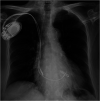Case Report: A leadless and endovascular pacemaker teamwork
- PMID: 38028465
- PMCID: PMC10666049
- DOI: 10.3389/fcvm.2023.1287506
Case Report: A leadless and endovascular pacemaker teamwork
Abstract
Background: Cardiac Implantable Electronic Device infections increase short- and long-term mortality, along with healthcare costs. Leadless pacemakers (PM) were developed to overcome pocket- and minimize lead-related complications in selected high-risk patients. Recent advancements enable leadless devices to mechanically detect atrial activity, facilitating atrioventricular (AV) synchronous stimulation.
Case summary: A 90-year-old woman, implanted with a dual-chamber pacemaker eight years ago due to sinus node dysfunction, presented with syncope. A diagnosis of complete AV block, in the setting of ventricular lead dysfunction was made. Due to a high risk of infection, the patient was implanted with a leadless PM capable of maintaining AV synchrony in VDD mode (MICRA™ model MC1AVR1). The transvenous PM was programmed to AAI-R mode to drive the atria, which, in turn, triggered the leadless PM to stimulate the ventricles. At six month follow-up, the AV synchrony rate was 85%.
Conclusion: The combination of classic atrial pacing with leadless ventricular stimulation can be used in high-risk patients to reduce the risk of complications, in the setting of ventricular lead dysfunction. In this manner, AV synchrony can be maintained, improving hemodynamic parameters and quality of life. Low sinus rate variability at rest is essential to achieve a high AV synchrony rate in such cases.
Keywords: atrioventricular synchrony; device infection; endovascular pacemaker; lead dysfunction; leadless pacemaker.
© 2023 Zeriouh, Sousonis, Menè, Boveda, Voglimacci-Stephanopoli and Combes.
Conflict of interest statement
The authors declare that the research was conducted in the absence of any commercial or financial relationships that could be construed as a potential conflict of interest.
Figures





References
-
- Habib G, Lancellotti P, Antunes MJ, Bongiorni MG, Casalta JP, Del Zotti F, et al. 2015 ESC guidelines for the management of infective endocarditis: the task force for the management of infective endocarditis of the European Society of Cardiology (ESC). Endorsed by: European Association for Cardio-Thoracic Surgery (EACTS), the European Association of Nuclear Medicine (EANM). Eur Heart J. (2015) 36(44):3075–128. 10.1093/eurheartj/ehv319 - DOI - PubMed
-
- Poole JE, Gleva MJ, Mela T, Chung MK, Uslan DZ, Borge R, et al. Complication rates associated with pacemaker or implantable cardioverter-defibrillator generator replacements and upgrade procedures: results from the REPLACE registry. Circulation. (2010) 122(16):1553–61. 10.1161/CIRCULATIONAHA.110.976076 - DOI - PubMed
Publication types
LinkOut - more resources
Full Text Sources

